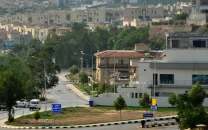Aftershock getaway
For them, freedom was a larger concern than safety.

District Prison Malir was amongst the many areas in Karachi that experienced mild earthquake tremors in recent days. While this led to mass panic and building evacuations in most places, 213 inmates captive in the Malir prison instead saw it as an opportunity and orchestrated one of the largest jailbreaks in Pakistan.
For them, freedom was a larger concern than safety. Since then, 78 prisoners have been recaptured. According to the Inspector General of Police in Sindh, this mass escape was the direct result of letting around 2,000 prisoners out into the courtyard as a safety precaution, who were then enabled to escape due to "some lapses".
The entire incident calls into question not only the enacted security measures that allow for lapses with such colossal consequences, but also an evident gap in the jail administration's safety training and crisis management competence.
According to international safety guidelines, you are advised to 'drop, cover and hold on' during earthquake tremors and only evacuate if there are signs of immediate danger afterwards.
Moreover, there are reportedly more than 6,000 prisoners in the Malir jail, while its capacity ceases at 2,200. Such flagrant violations of multiple safety standards are naturally a recipe for disaster that cannot be prevented, only dealt with. The prison's superintendent insists that the jailbreak was "not a security lapse" but rather all due to "a natural disaster."
While an unusual situation transpired due to the natural disaster, it is essential for security personnel to be trained in unusual situations, so that a 'timely response' does not have to refer to recapturing 78 escaped prison inmates.
The IG Sindh has ascertained that the prisoners escaped by opening the door of the jail. In a facility designed to make the outside world inaccessible for thousands, why was that an achievable feat?














COMMENTS
Comments are moderated and generally will be posted if they are on-topic and not abusive.
For more information, please see our Comments FAQ